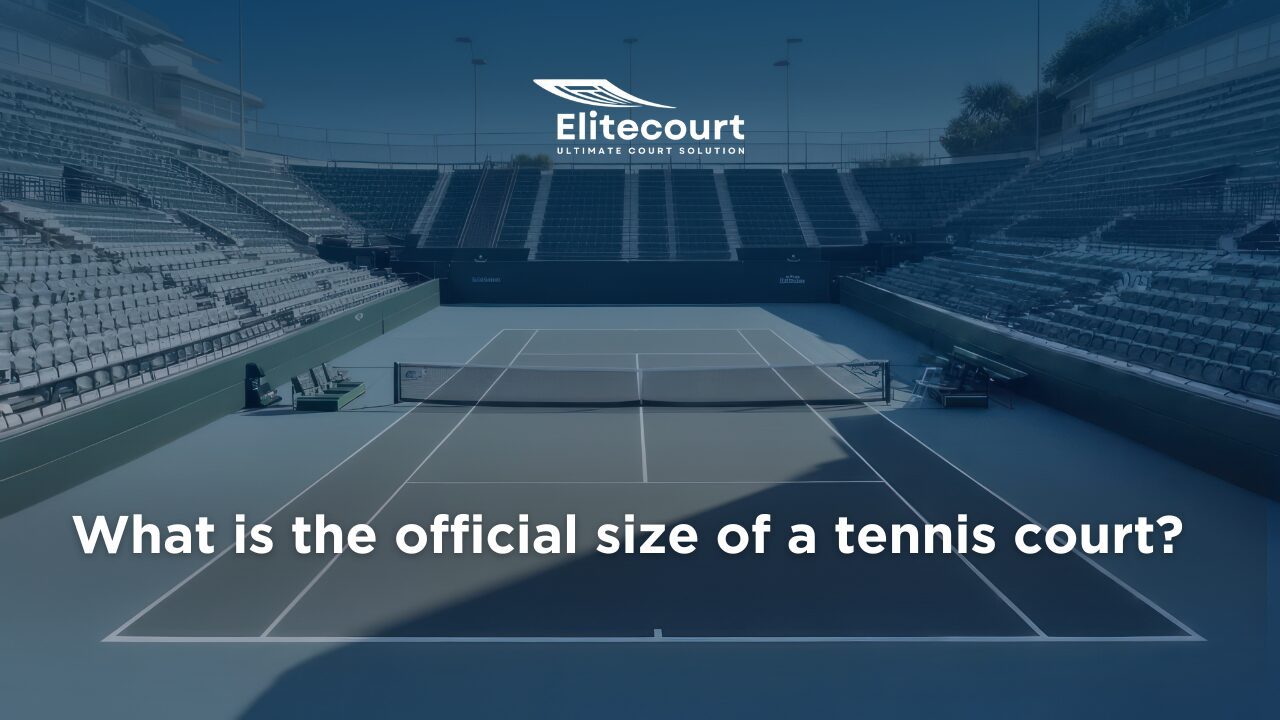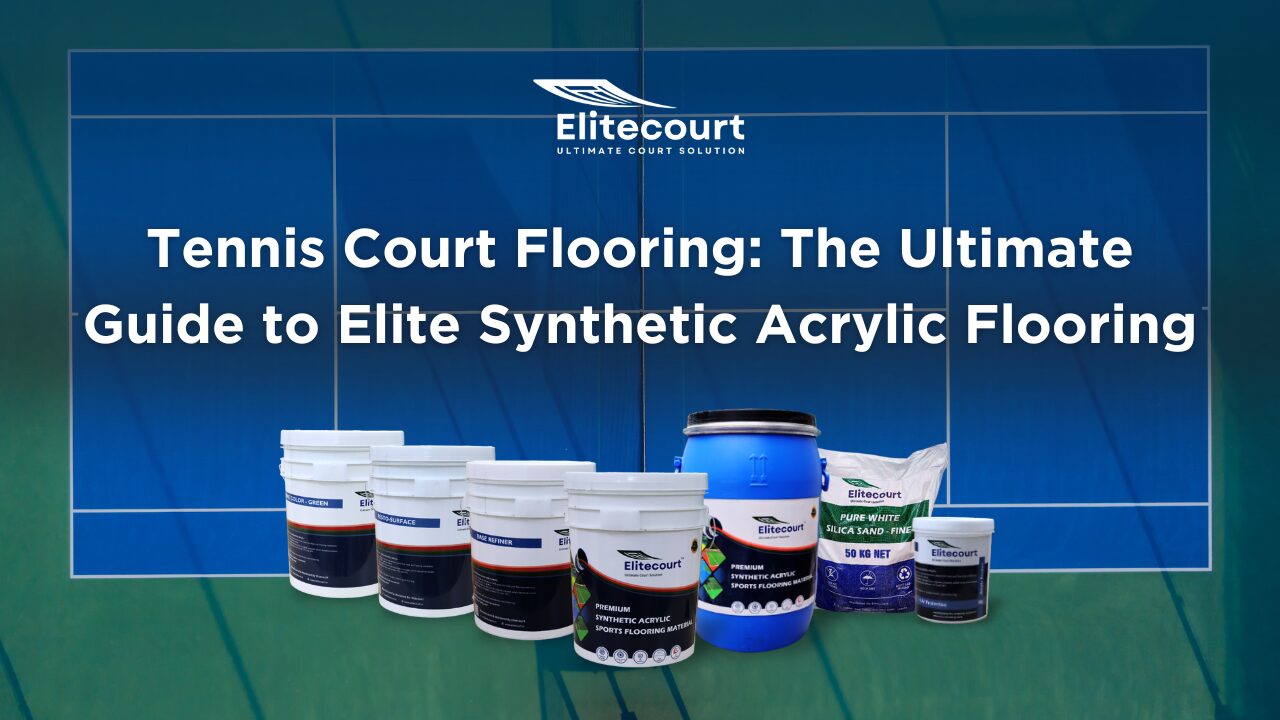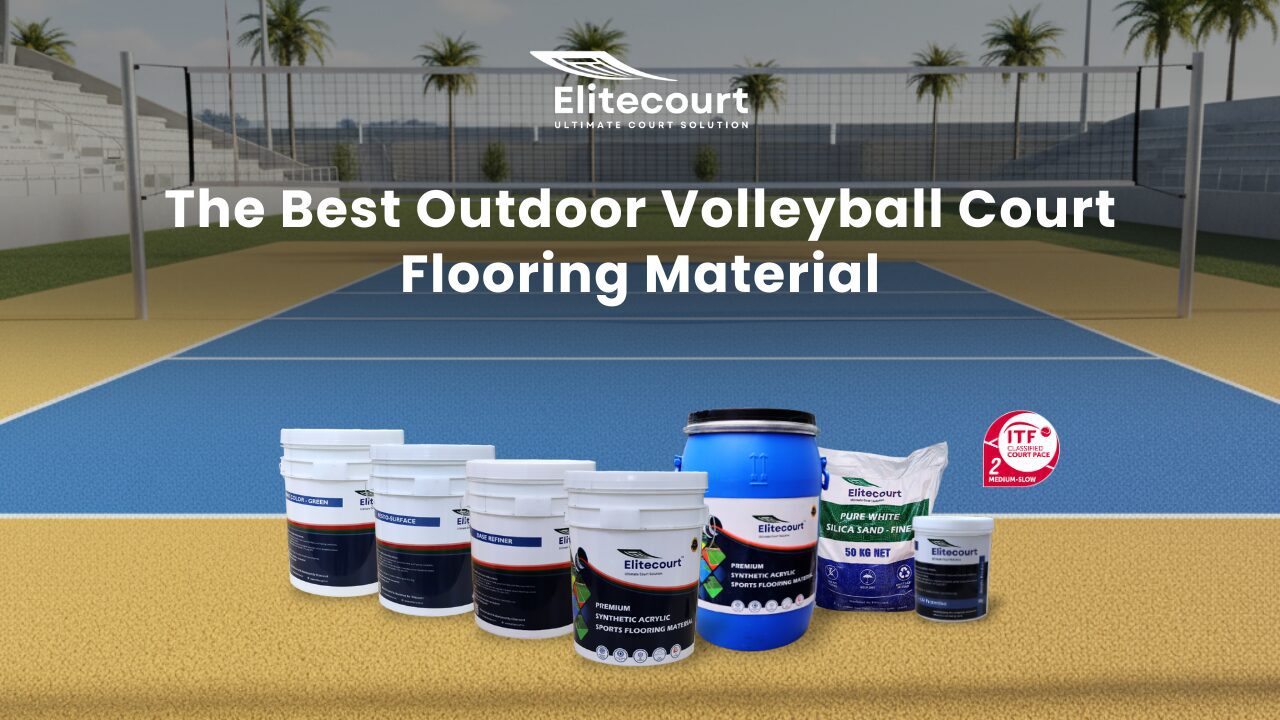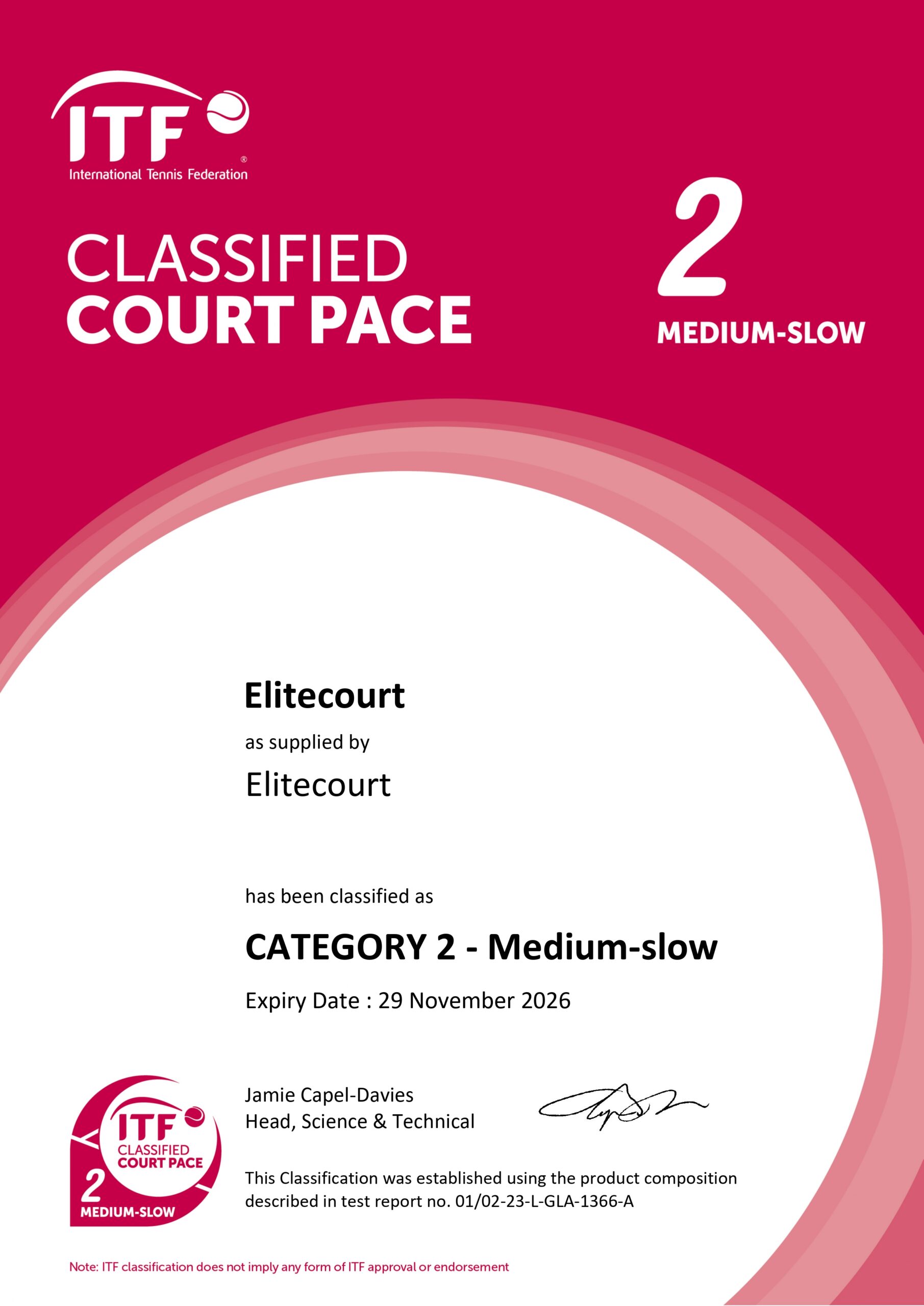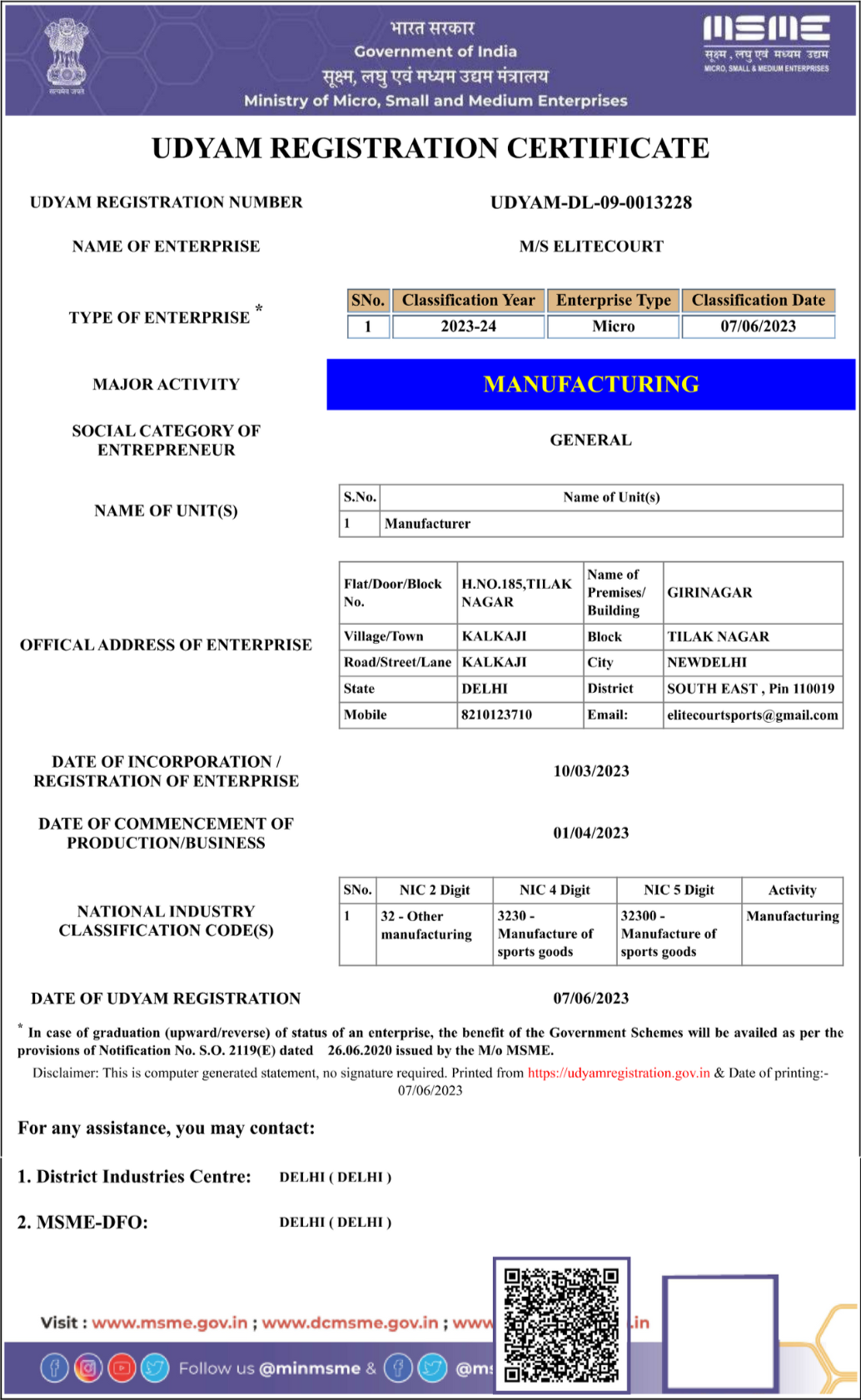Can You Play Pickleball on a Tennis Court?
Elitecourt, India’s trusted manufacturer of premium synthetic acrylic sports flooring, brings years of experience crafting high-performance courts. With proven reliability and expertise, Elitecourt delivers durable, precision-engineered surfaces designed for tennis, pickleball, and multi-sport adaptability.
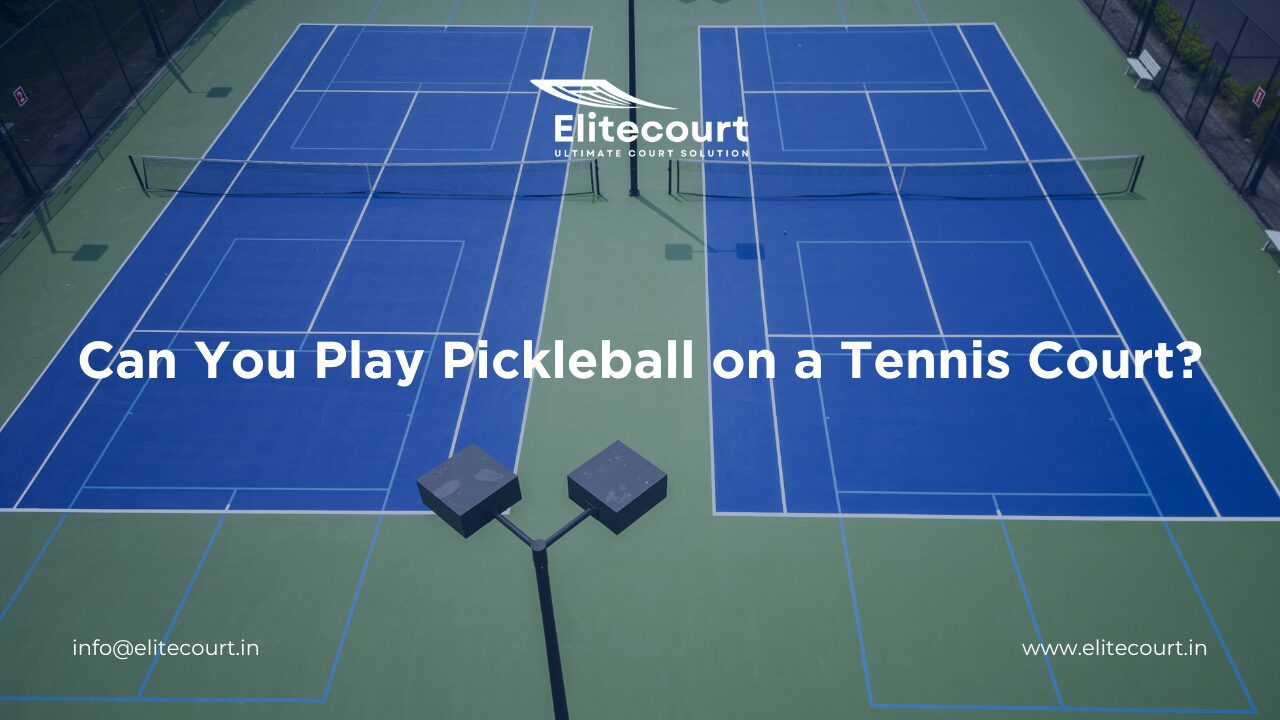
Table of Contents
Introduction: Can You Play Pickleball on a Tennis Court?
Yes, you can absolutely play pickleball on a tennis court—and it’s becoming more common across the world. The adaptability of a tennis court’s surface, especially when it’s made of high-quality synthetic acrylic flooring like those from Elitecourt, makes it easy to transform into a pickleball play zone with minimal modification.
In many communities, schools, and sports complexes, tennis courts are now serving dual purposes. With the rapid rise of pickleball’s popularity, it only makes sense to use existing tennis spaces rather than building new facilities from scratch. Both sports share similar foundation requirements—a smooth, level, and resilient surface that offers consistent bounce and traction.
However, while you can play pickleball on a tennis court, doing it right involves understanding a few crucial aspects: court dimensions, markings, and surface adaptability. That’s where manufacturers like Elitecourt step in, providing the kind of acrylic flooring that supports both sports without compromising performance or player safety.
Think of it like this: a tennis court is the big brother, while pickleball is its agile younger sibling. Both thrive on the same kind of environment, but they each demand unique spatial layouts and line markings. The right flooring ensures both can coexist seamlessly.
So, whether you’re a club owner, sports facility manager, or just curious about converting your tennis space into a pickleball-friendly zone, this guide will walk you through everything you need to know—from technical compatibility to Elitecourt’s flooring advantages.
Understanding the Basics: What Is Pickleball?
Before diving deeper into conversions and compatibility, let’s start with what pickleball actually is. Pickleball is a paddle sport that combines elements of tennis, badminton, and table tennis. Played with a paddle and a perforated plastic ball (similar to a wiffle ball), it’s enjoyed by players of all ages and skill levels.
The sport originated in the mid-20th century and has exploded in popularity worldwide, particularly in North America and increasingly in India. It’s loved for its accessibility, quick learning curve, and social gameplay.
A standard pickleball court measures 20 feet wide by 44 feet long—much smaller than a tennis court. The net height is also slightly lower, standing at 34 inches at the center and 36 inches at the sides. The game is typically played as doubles, though singles are becoming more popular.
Here’s a quick comparison table for clarity:
| Aspect | Pickleball | Tennis |
|---|---|---|
| Court Dimensions | 20’ x 44’ | 36’ x 78’ |
| Net Height | 34” center | 36” center |
| Equipment | Paddle & perforated ball | Racket & tennis ball |
| Players | 2 or 4 | 2 or 4 |
| Play Area | Smaller, slower pace | Larger, faster pace |
Pickleball emphasizes precision and placement over raw power, making it perfect for players who want to stay active without the high-impact demands of tennis. Its smaller court size also allows four pickleball courts to fit comfortably within one tennis court—a clever way to maximize space.
With these basics in mind, let’s explore how both sports align and why a tennis court built with Elitecourt’s acrylic system makes the perfect candidate for dual-sport play.
Pickleball vs. Tennis: Key Differences in Court Size and Play
While both games share a rectangular surface and a net, they differ in their dimensions, pace, and style of play. Understanding these differences is key to effectively adapting a tennis court for pickleball.
A tennis court spans 78 feet in length and 36 feet in width (for doubles), offering a large space for fast-paced rallies and wide-angle shots. A pickleball court, on the other hand, is compact—44 feet long and 20 feet wide—leading to shorter rallies and more controlled exchanges.
The net height difference, though small, also affects gameplay. Pickleball’s slightly lower net allows for smoother volleys and strategic dinks at the net—a hallmark of the sport’s charm.
From a flooring perspective, both games require a non-slip, consistent-bounce surface—qualities found in Elitecourt’s synthetic acrylic systems. These surfaces are engineered for even ball response and player comfort, making transitions between sports effortless.
Let’s break down a few play-style contrasts:
- Movement: Tennis involves longer sprints and directional changes; pickleball focuses on lateral quick steps.
- Shots: Tennis favors topspin and power; pickleball rewards finesse and strategy.
- Equipment: The paddle’s solid surface changes how the ball reacts—requiring slightly less surface friction.
Despite these distinctions, both sports thrive on smooth, cushioned acrylic flooring, ensuring optimal traction and safety. With the right markings and equipment, any well-built tennis court can easily host pickleball matches without damaging the flooring or affecting performance.
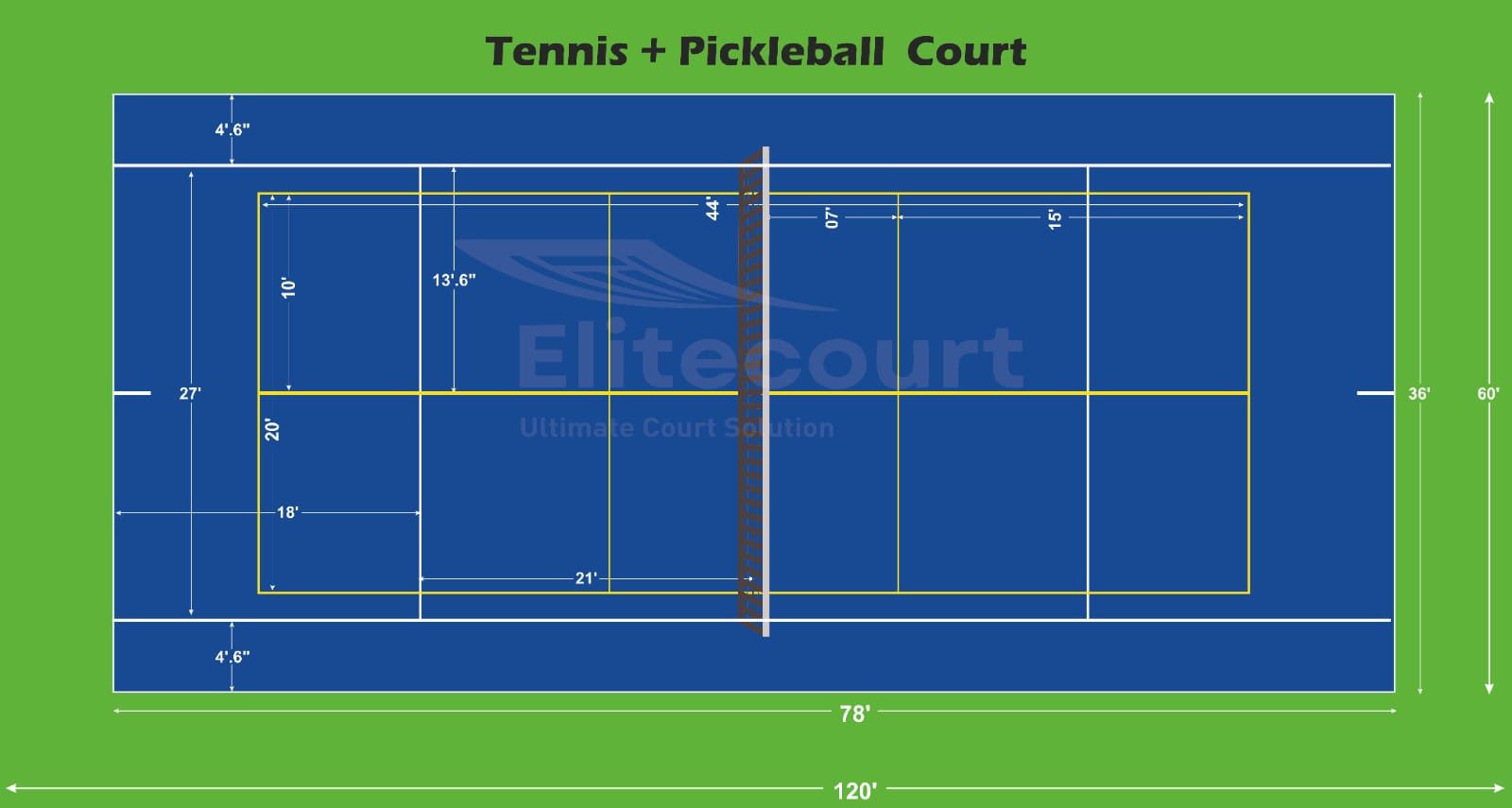
The Compatibility Question: Why Tennis Courts Can Host Pickleball
The reason you can play pickleball on a tennis court lies in the structural and material compatibility of the two sports. Tennis courts, especially those constructed using Elitecourt’s premium synthetic acrylic layers, already possess all the foundational elements pickleball needs: a flat, durable, and resilient surface.
Acrylic courts are built to withstand high-impact foot traffic, weather changes, and continuous ball strikes—characteristics that make them ideal for pickleball as well. The consistent bounce, controlled traction, and slip resistance ensure safety and playability for both sports.
Moreover, tennis courts offer ample space. You can easily fit up to four pickleball courts within one tennis layout. By using temporary boundary lines or tape, facility managers can convert courts as needed, allowing players to enjoy both sports without costly structural changes.
Another reason for compatibility is surface texture. Pickleball benefits from the same medium-rough finish used for tennis because it provides a balanced grip-to-glide ratio. The flooring doesn’t need to be resurfaced—just re-marked.
Expert Tip:
When choosing surface materials for dual-use courts, always opt for high-grade acrylic coatings that maintain integrity under varied game styles. Elitecourt’s advanced formulations deliver this balance, offering multi-sport versatility without compromising quality.
In short, not only can you play pickleball on a tennis court, but when the surface is made with Elitecourt flooring, you’ll enjoy professional-level performance for both games—all on one seamless surface.
Converting a Tennis Court into a Pickleball Court
Converting a tennis court into a pickleball court can be as simple or sophisticated as you like. For most facilities, temporary conversion works best. This involves applying removable pickleball lines and installing portable nets without affecting the existing tennis setup.
Here’s a basic conversion approach:
- Mark the boundaries using chalk, tape, or removable paint.
- Install portable pickleball nets at the correct height (34 inches center).
- Position the courts—typically four pickleball courts fit within one tennis layout.
- Check for proper spacing to avoid player interference.
- Ensure the surface is clean and free of debris for consistent play.
Permanent conversions require painting new lines and potentially adjusting the net posts, but with Elitecourt’s precision coating technology, new markings can be applied cleanly without affecting surface quality.
Acrylic floors are resilient enough to handle multiple line sets, meaning you can have both tennis and pickleball lines coexisting—each with different colors for easy differentiation.
The key is visibility. Contrasting color markings help players identify boundaries instantly, reducing confusion during play. Elitecourt’s flooring systems support vibrant, UV-stable pigments that maintain clarity over time, ensuring your hybrid court stays professional-looking and functional.
Elitecourt’s Role in Multi-Sport Court Solutions
When it comes to multi-sport flooring, Elitecourt stands as one of India’s most trusted manufacturers of synthetic acrylic sports surfaces. The company’s expertise lies in engineering floors that seamlessly accommodate sports like tennis, pickleball, basketball, and badminton — all without compromising performance, durability, or aesthetics.
Elitecourt’s multi-layer acrylic system ensures a consistent ball bounce, optimal traction, and surface resilience. Whether the game involves the fast, high-bounce rallies of tennis or the quick, low-impact volleys of pickleball, the flooring provides uniform response across the entire court.
Here’s why Elitecourt’s flooring is a perfect fit for hybrid or multi-sport courts:
- Superior Surface Uniformity: Each layer of Elitecourt’s acrylic system is applied with precision, creating a perfectly leveled finish ideal for both small and large-court games.
- Weather Resistance: The surface maintains its integrity under India’s varied climates—heat, humidity, and rain don’t compromise the playing experience.
- Player Comfort: Engineered to absorb impact and reduce fatigue, ensuring player safety during longer matches.
- Aesthetic Versatility: Available in a wide range of vibrant, UV-resistant colors, making it easy to mark both pickleball and tennis boundaries distinctly.
What sets Elitecourt apart is its commitment to quality and consistency. Every acrylic mix is developed using industry-proven formulas and tested for international standards of grip, friction, and resilience. This makes their surfaces multi-sport ready right from the manufacturing stage.
For facility owners or sports clubs looking to maximize court usage, Elitecourt flooring offers the flexibility to host multiple sports on a single surface, allowing both pickleball and tennis enthusiasts to enjoy their games without any compromises in playability or longevity.
Surface Considerations: Why Acrylic is Ideal for Both Games
The heart of a great playing experience lies in the court surface, and that’s where acrylic systems shine. Synthetic acrylic flooring—like the kind manufactured by Elitecourt—offers a perfect balance between durability, safety, and performance.
Both tennis and pickleball demand a surface that can handle fast footwork, controlled slides, and consistent ball bounce. Acrylic coatings provide precisely that. Their non-porous, weatherproof structure ensures that neither rain nor temperature swings impact gameplay or surface quality.
Let’s explore the main benefits of acrylic flooring for both sports:
- Friction Balance: The slightly textured surface ensures grip for quick lateral movements, reducing slip risks without hindering mobility.
- Ball Consistency: Acrylic coatings produce an even bounce, which is crucial for both tennis and pickleball, ensuring predictable gameplay.
- UV Resistance: Unlike traditional cement or asphalt, Elitecourt’s UV-stable coatings resist fading and surface brittleness, keeping courts vibrant and functional for years.
- Low Maintenance: The seamless surface prevents dust and water accumulation, making cleaning and upkeep simple and cost-effective.
- Eco-Friendly Options: Elitecourt’s formulations are environmentally safe, using low-VOC (Volatile Organic Compound) materials.
Pro Tip: If you’re planning for multi-sport usage, opt for medium-texture acrylic surfaces. They strike the perfect balance between control and comfort, supporting both quick-footed tennis rallies and controlled pickleball exchanges.
Another key reason acrylic is favored is longevity. Unlike modular tiles or rubberized flooring that may shift or warp over time, acrylic systems bond firmly with the underlying base, maintaining integrity even after years of heavy play.
This durability ensures that sports facilities, academies, and clubs can confidently use one surface for both tennis and pickleball without constant resurfacing or repairs—making acrylic the smart and sustainable choice.
Transform Your Sports Facility Today!
Contact us for high-quality synthetic sports flooring material and elevate your space!
Can You Play Both Sports on the Same Court?
Absolutely! You can easily play both pickleball and tennis on the same court by integrating multi-sport markings and using flexible equipment. It’s a practical and increasingly popular approach in modern sports facilities that want to maximize usage and attract diverse player groups.
Here’s how it’s typically managed:
- Dual Line Markings: Tennis lines are usually painted white, while pickleball lines can be painted in a contrasting color like yellow or blue for easy visibility.
- Adjustable Nets: Using portable or adjustable net systems allows easy height adjustment between the two sports.
- Scheduling System: Facilities can allocate specific time slots for tennis and pickleball to prevent overcrowding or confusion.
- Clear Signage: Posting clear visual guides helps players quickly identify which lines belong to which sport.
The main challenge in sharing courts is ensuring clarity in markings and preventing player confusion, but this is easily solved through professional line planning—a service that Elitecourt’s team often guides clients through during flooring projects.
The adaptability of Elitecourt’s acrylic surfaces also ensures that switching between the two games doesn’t strain the flooring. The coatings maintain consistent traction and ball response for both sports, eliminating concerns about wear differences.
Expert Advice: Use semi-permanent pickleball markings when dual usage is frequent. They provide long-term visibility without impacting tennis aesthetics.
By thoughtfully organizing layout and markings, a single Elitecourt-finished tennis court can double as a multi-sport arena—an efficient solution for schools, clubs, and communities seeking maximum sports engagement.
Safety Factors: Protecting Players and the Court
When adapting a tennis court for pickleball, safety should be the top priority. Both sports involve quick movements, sudden pivots, and repeated foot strikes—activities that can put strain on joints and muscles if the flooring isn’t optimized for shock absorption and grip.
Elitecourt’s acrylic surfaces are engineered with player safety in mind, combining comfort, control, and resilience.
Here are some key safety features that make these surfaces ideal:
- Shock Absorption: The acrylic cushioning system minimizes stress on knees and ankles during fast play.
- Slip Resistance: The micro-textured surface prevents skidding, even during sudden direction changes or light rain.
- Traction Control: The grip level remains consistent, reducing the risk of falls or sprains.
- Drainage Design: Proper slope and surface coating prevent water accumulation, ensuring playability even after rainfall.
- Low Glare Finish: The matte coating minimizes sun glare, enhancing visibility for players during outdoor games.
For facilities maintaining both sports, it’s crucial to inspect courts regularly. Check for fading lines, surface cracks, or worn-out texture—these can affect gameplay and increase risk of injuries.
Elitecourt’s advanced coating systems are built to withstand heavy usage and environmental exposure, maintaining optimal play conditions year-round. The company’s multi-layer protection ensures that even under constant dual-sport use, the surface doesn’t lose its grip, elasticity, or aesthetic appeal.
In short, a well-designed acrylic sports court by Elitecourt not only allows both tennis and pickleball but also ensures every serve, volley, and rally happens on a surface built for safety and performance.
Line Marking and Visibility Tips for Multi-Sport Courts
When converting a tennis court for pickleball, line marking plays a crucial role in defining play boundaries clearly for both games. Done right, it enhances player experience and prevents confusion.
Here’s how to achieve optimal visibility and layout design:
- Use Contrasting Colors: For example, keep tennis lines in white and pickleball lines in a bright, contrasting shade such as yellow, orange, or blue.
- Follow Standard Dimensions: Ensure all pickleball markings adhere to the USA Pickleball Association (USAPA) standards or other recognized global guidelines.
- Avoid Overcrowding Lines: Proper spacing between line sets helps players easily distinguish them during fast-paced games.
- Consider Reflective Coatings: For evening play, reflective or light-colored lines can improve visibility under artificial lighting.
- Professional Application: Use experienced installers familiar with acrylic sports coatings to ensure clean, durable, and weatherproof markings.
Expert Insight: Elitecourt’s acrylic systems are formulated to hold pigment longer than standard coatings, preventing color fading even after extensive play and exposure to sunlight.
A well-marked court also improves the overall aesthetic appeal of your facility. Vibrant color combinations not only aid functionality but also create a visually dynamic sports space that attracts players and spectators alike.
With Elitecourt’s quality acrylic base, line markings remain crisp and clear for years—allowing both tennis and pickleball to coexist harmoniously without constant repainting or confusion.
Transform Your Sports Facility Today!
Contact us for high-quality synthetic sports flooring material and elevate your space!
Common Challenges and Smart Solutions
While playing pickleball on a tennis court is convenient, it’s not without challenges. However, with the right planning and the right surface, these issues are easy to overcome.
Challenge 1: Confusing Court Lines
Solution: Use distinct, high-contrast colors for each sport’s boundaries. Elitecourt’s wide palette of acrylic pigments allows for perfect color separation that remains vibrant even in harsh sunlight.
Challenge 2: Ball Interference in Shared Play
Solution: When multiple pickleball courts are set up on one tennis court, use portable net dividers or staggered schedules to avoid cross-play interruptions.
Challenge 3: Uneven Wear and Tear
Solution: Rotate play areas and conduct periodic cleaning and minor resurfacing. Elitecourt’s multi-layer coatings allow easy reapplication without removing the existing base.
Challenge 4: Space Utilization
Solution: Optimize layout by aligning courts diagonally or using partial-court configurations, especially for community play zones.
Quick Tip: Elitecourt flooring allows easy repainting and line customization, so you can adjust layouts as your facility grows or player demand changes.
By identifying these common issues early and applying Elitecourt’s engineered flooring solutions, you ensure that your multi-sport courts remain safe, durable, and ready for both games year-round.
Expert Tips: Maintaining Acrylic Sports Floors
Proper maintenance is the secret to ensuring your Elitecourt acrylic sports surface continues to perform at its best, whether it’s being used for tennis, pickleball, or any other court sport. Even though these flooring systems are designed for longevity and low upkeep, consistent care enhances performance, safety, and visual appeal.
Let’s look at the key maintenance practices for acrylic sports courts:
Routine Cleaning
Dirt, dust, and debris can accumulate on the surface and reduce traction. Regular sweeping or gentle pressure washing keeps the court clean and helps maintain grip consistency. Avoid harsh chemicals that can dull or damage the surface finish.
Pro Tip: Use a soft-bristle broom or a microfiber mop for dry cleaning. For deep cleaning, mild soap mixed with water is sufficient—no need for abrasive scrubbing.
Regular Inspections
Inspect the court periodically for surface cracks, worn-out lines, or fading colors. Acrylic coatings are durable, but exposure to sun and constant play can lead to minor wear over time. Timely touch-ups prevent small issues from escalating into major resurfacing needs.
Re-Coating
Every few years, depending on usage intensity, applying a fresh acrylic layer revitalizes the surface. Re-coating restores texture and enhances the color vibrancy, ensuring both tennis and pickleball lines remain visible and functional.
Water Drainage Management
Elitecourt surfaces are designed to resist water pooling, but maintaining proper slope and drainage channels is crucial. Standing water can cause discoloration or mold buildup if left unattended. Always ensure nearby drains are clear.
Seasonal Adjustments
In areas with varying weather patterns, courts can experience expansion and contraction. During intense heat, avoid using heavy machinery on the court, and during monsoon seasons, cover or dry surfaces promptly to avoid waterlogging.
Expert Insight: Elitecourt’s acrylic formulation minimizes thermal expansion and resists UV damage, ensuring that even with seasonal temperature changes, your court stays stable and consistent.
Player Footwear Awareness
Encourage players to wear non-marking shoes. Regular athletic soles can leave dark scuffs on acrylic surfaces, affecting the appearance and grip over time.
By following these simple yet effective maintenance practices, your Elitecourt flooring will continue to provide professional-grade performance for years. The beauty of acrylic courts lies in their resilience—when properly cared for, they deliver consistent bounce, vibrant color, and long-term value across multiple sports.
Pickleball Popularity and the Growing Demand for Hybrid Courts
Pickleball’s meteoric rise across the world has completely transformed how facilities approach sports infrastructure. Once considered a niche pastime, pickleball has now become one of the fastest-growing recreational sports globally, attracting players from all age groups.
This surge in interest has directly influenced the demand for hybrid courts—spaces that can support both tennis and pickleball. Communities, schools, and clubs recognize that not everyone has the space or budget to build separate courts, making the idea of multi-sport adaptability both economical and practical.
The good news? Tennis courts, especially those built with Elitecourt’s durable acrylic flooring, can easily accommodate this shift. Their non-porous, slip-resistant, and weatherproof construction ensures that both sports can be played comfortably and safely.
Let’s explore some key reasons driving the popularity of pickleball and hybrid court setups:
- Accessibility: Pickleball is easier to learn than tennis, making it popular among new players.
- Social Nature: Its doubles format encourages social play, community bonding, and friendly competition.
- Low Impact: The smaller court and lighter ball mean less physical strain, attracting older adults and youth alike.
- Facility Optimization: Tennis courts that once saw reduced usage are now revitalized with the addition of pickleball lines.
Elite Insight: Sports complexes using Elitecourt flooring systems can support both games without extra wear and tear, thanks to the brand’s high-tensile acrylic blend that maintains consistency across different play styles.
In India, this trend is quickly gaining traction. Recreational centers, schools, and housing communities are embracing multi-sport courts to engage more players, promote fitness, and make better use of limited space.
As pickleball continues to grow, hybrid setups will become the new standard—making Elitecourt flooring solutions the backbone of this modern sporting evolution.
Why Choose Elitecourt for Sports Flooring Solutions
Choosing the right flooring is the foundation of a successful sports facility, and Elitecourt stands out as India’s go-to manufacturer for synthetic acrylic sports surfaces. With years of experience and a proven track record across the nation, the company’s name has become synonymous with quality, performance, and trust.
Here’s why Elitecourt is the preferred choice for tennis and pickleball flooring:
Manufacturer Expertise
Unlike many service-based vendors, Elitecourt focuses exclusively on manufacturing premium-grade sports flooring materials, ensuring total control over quality, formulation, and consistency.
Scientifically Engineered Acrylic Systems
Each product is developed through rigorous research and testing. The multi-layer acrylic structure enhances durability, traction, and UV stability, making it ideal for India’s diverse climate conditions.
Multi-Sport Compatibility
Elitecourt surfaces are engineered to perform equally well across multiple games—tennis, pickleball, basketball, and volleyball—without needing different flooring types.
Aesthetic and Functional Versatility
The range of vibrant color options allows for easy customization of court lines and surfaces, helping you design visually distinct and professional-grade multi-sport arenas.
Long-Term Reliability
Elitecourt flooring maintains consistent performance even after years of heavy use. Its weatherproof coatings resist fading, cracking, and delamination—ensuring a lasting return on investment.
Pro Tip: When designing a hybrid court, choose Elitecourt’s medium-textured acrylic finish for the perfect balance between ball control and player comfort.
Whether you’re a sports club, educational institution, or community center, Elitecourt offers the expertise, innovation, and product reliability you need to create world-class courts that support both tennis and pickleball effortlessly.
By investing in Elitecourt’s premium acrylic systems, you’re not just building a surface—you’re building a long-term sporting experience that emphasizes quality, safety, and performance.
Transform Your Sports Facility Today!
Contact us for high-quality synthetic sports flooring material and elevate your space!
Conclusion: Tennis or Pickleball—A Perfect Match on One Surface
So, can you play pickleball on a tennis court? Absolutely—and you can do it confidently when the surface is made with Elitecourt’s advanced acrylic flooring. The synergy between these two sports lies in their shared need for a smooth, consistent, and durable playing surface—something Elitecourt has perfected through its state-of-the-art materials.
From effortless conversions and clear multi-sport markings to long-lasting durability and all-weather performance, Elitecourt’s flooring systems make it possible for both games to thrive side by side.
Whether you’re transforming an existing tennis facility or designing a new multi-sport venue, choosing Elitecourt ensures that your courts are built for versatility, safety, and lasting excellence.
Elitecourt doesn’t just manufacture flooring—it creates play-ready foundations for the future of sports.
FAQs
Yes, you can. Permanent conversions involve repainting lines and adjusting net posts to match pickleball dimensions. Elitecourt’s acrylic surfaces support multiple line layers, so repainting or re-marking can be done seamlessly without affecting court quality.
Typically, four pickleball courts can fit comfortably on a single standard tennis court. This configuration maximizes space and encourages group play while maintaining safe spacing between courts.
Not at all—if your court uses Elitecourt’s synthetic acrylic flooring. The specialized coating allows for multi-line applications without peeling or color blending issues. Properly applied lines actually enhance the court’s versatility.
A synthetic acrylic surface is ideal. It provides balanced traction, consistent bounce, and high durability, making it suitable for both high-speed tennis and precise pickleball play. Elitecourt’s medium-textured finish is perfect for hybrid courts.
Use contrasting colors—white for tennis and yellow or blue for pickleball. Elitecourt’s high-pigment, UV-resistant coatings ensure the colors remain sharp and distinct, even under bright sunlight or heavy use.
Final Thoughts
In the evolving world of sports, flexibility and innovation define success. By choosing Elitecourt’s synthetic acrylic systems, facilities can offer both tennis and pickleball on a single, high-quality surface that enhances performance, safety, and durability.
Elitecourt continues to set the standard for India’s sports flooring industry, empowering every serve, smash, and rally to happen on courts built with excellence.

